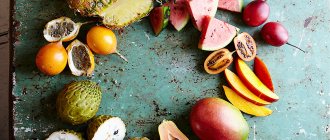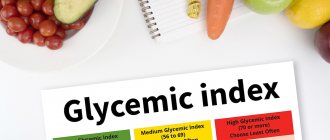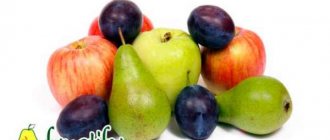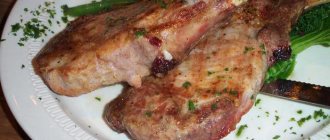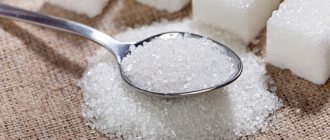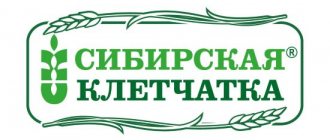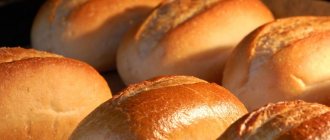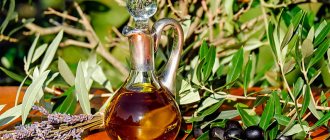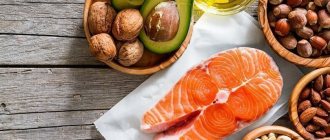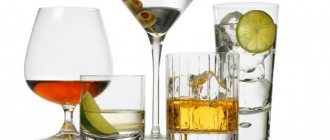From early childhood we hear that vegetables, fruits and greens are very beneficial for our health. This statement is true, because these food products contain many vitamins, minerals (micro- and macroelements) and other important substances necessary for the normal development and functioning of the body. Vegetables, fruits and greens contain a minimum of calories, so nutritionists recommend that all people who are struggling with excess weight, watching their figure and leading a healthy lifestyle, introduce these foods into their diet.
But low calorie content is not the most important indicator. When drawing up a dietary menu, it is necessary to take into account such important aspects as the glycemic index and glycemic load. It is these indicators that help you understand how quickly carbohydrates are broken down and how quickly they are absorbed by the body.
Do you want to know which vegetables, fruits and greens promote weight loss and are good for our health, and which ones should not be consumed if you dream of a thin waist and tummy without an extra gram of fat? Just look at the calorie table for vegetables, fruits and herbs, which we created especially for you.
Calorie content, glycemic index and glycemic load of vegetables and fruits
Calorie content is a very important, but far from the only indicator that needs to be taken into account when creating an individual diet.
Calorie content should be considered in conjunction with the glycemic index (GI) and glycemic load (GL).
The glycemic index is the rate at which blood sugar levels rise after eating a certain food. The lower the GI, the slower the blood sugar level rises after consuming the product. A high GI promotes the rapid production of insulin in large quantities, thanks to which you get a lot of energy and strength in a short period of time after eating. If you are waiting for an intense workout in the gym, then there is nothing wrong with eating a vegetable or fruit that has a high GI. If you rest passively, then the excess energy that is not useful to you will be converted and stored in the body in the form of fat deposits.
Glycemic load is an indicator that demonstrates the speed, intensity and duration of changes in blood sugar levels. Thanks to GN, you can understand which vegetables and fruits will keep your blood sugar levels down for the longest time so that you can exclude them from your diet.
The lower the level of the glycemic index and glycemic load, the fewer calories that enter the body will remain in it in the form of extra pounds and centimeters on the waist. Thus, people who are losing weight and leading a healthy lifestyle are not recommended to eat potatoes, because they not only contain a lot of calories, but also have a high GI, the level of which increases even more when cooked.
Sweet and ripe fruits contain more calories and sugar than slightly unripe fruits. Therefore, give preference to fruits that are not too sweet and slightly unripe, which contain a lot of dietary fiber (fiber) and little sugar.
After heat treatment, the rate of energy release from carbohydrates increases significantly, since dietary fiber is greatly destroyed during cooking. Because of this, complex carbohydrates are transformed into simple ones. The body has to spend much more energy processing complex carbohydrates, which saturate the body slowly and gradually, than processing simple carbohydrates. Therefore, eat as many vegetables and fruits as possible in their raw form.
You should not chop vegetables or fruits very finely, because the speed of their absorption by the body depends on the size of the chopped pieces. Dietary fiber, which slows down the breakdown of carbohydrates, is destroyed when crushed. Therefore, it is recommended to eat fruits and vegetables whole or cut into large pieces.
Store and transport fruits and vegetables.
With the exception of dried figs, prunes and raisins, the other fruits on our list are fresh. Whether you want to take them on the go or save them for emergencies, obviously you won't be able to do that while they're fresh. You must use some preservation methods to preserve them for a long time or to make them easier to transport.
One way to preserve these foods is to freeze-dry them or simply dehydrate them. Either of these two methods will extend the life of any type of food, from meat to vegetables. Freeze-drying and dehydration remove the water content of food. Since food contains bacteria, the moisture will spoil quickly.
The exclusion of water content results in virtually no microorganisms able to survive in a dry or dehydrated environment. This holds food for a long time. Freeze drying is considered a method that ensures that food can remain edible in its dry form. Even for decades.
Therefore, to ensure that the dry cold is done well and the result is satisfying, you must ensure that the vegetables or fruits of your choice are the freshest. He should not attempt to freeze dry fruits/vegetables that are old, have darker areas or soft areas on the surface and should not be beyond the ripe stage.
It is also important not to freeze dry foods that have been stored in the refrigerator or refrigerator. And of course, wash your food very well before you freeze dry it. Then cut your fruits and vegetables into small cubes or thin rolls and you're ready to store them.
Most people have freeze drying machines (vacuum chamber) that can get the job done within 24 hours and their fruits and vegetables can be freeze dried the next morning. But since these vacuum chambers aren't cheap, other people prefer the more traditional way of using their refrigerators to do the same thing. It will take a little longer, but the result is the same.
All you have to do is take the food (cut into pieces) and place it on a perforated rack or tray in the refrigerator . Make sure there is no other food in there, or that your freeze-dried food smells like all the other food in the refrigerator. Your fruits and vegetables will freeze in the first few hours.
After this, another stage begins, called sublimation. During this process, the moisture in the food will slowly evaporate. To help you understand, areas with freezing temperatures tend to be the driest. Antarctica is the driest place on Earth, even if you think it should be the Sahara Desert. So now that you look at your refrigerator and the food inside, you'll have a better understanding of how the freeze-drying process works.
Then, to see if your freeze-dried food is ready to be removed and stored, take a small portion and let it thaw. If the food turns black, you should let the rest continue the process. The thawed piece should be thrown away. Don't put it back in the refrigerator.
Another method for lyophilization uses dry ice. This process requires a little more care and attention as it will process CO2 (carbon dioxide). This is done using cameras (which you can also buy if you want). You leave food inside the chamber and pour CO2 on it. Make sure the dry ice completely covers the food. CO2 creates almost zero humidity in the environment. This will remove all the moisture and water from the fruits and vegetables. When the CO2 is gone, you will have ready-made freeze-dried products.
One word of caution though: keep the window open during this process as the CO2 will evaporate into a gaseous state. You don't want to breathe this at night. Also handle dry ice with thick gloves as it is very cold and can cause a sting within seconds. Don't let it touch your skin in a solid state.
Finally, once your food is freeze-dried and ready, you should quickly place it in plastic ziploc bags (vacuum bags) or, better yet, use a vacuum machine to vacuum the air out of the bag and preserve the food for a long time. You can then carry it into your backpack, put it in your first aid kit, your safe room, basement, etc.
In extreme situations, high-calorie vegetables and fruits can be a blessing. They still retain most of their nutrients and can therefore provide vitamins and minerals that are otherwise deficient in processed foods.
dehydrating This is much easier to do. This has been an ancient tradition all over the world, and people have been doing it for generations for the purpose of preserving food for winter seasons or years with little harvest.
The easiest way to dehydrate is to prepare wooden trays, place them in the sun, but make sure they are in a wooden box to keep the food free from dust, insects and rodents, but allow moisture to escape from the food. Within 3-4 days (depending on how hot, humid or dry the weather is), the food should be ready to be stored. Of course, there are dehydrators: machines you can buy that adjust all the necessary conditions to ensure food is dehydrated within 24 hours.
Here are some of the main differences between freeze-drying and dehydrating your food. . You will see which one is better and then you can decide for yourself which method to use.
Considering that the main factor in spoiled food is moisture, we must take this factor into account. When dehydrated, approximately 5-10% of the moisture will remain in the feed. When it comes to freeze drying, this amount is much lower, around 1-2%. This is a significant difference. This means that using freeze-drying as the primary method for preserving fruits and vegetables extends shelf life. Dehydration is not enough to keep your food completely intact for a long time.
On average, dehydrated foods have a shelf life of 15 (maximum 20) years. The use of lyophilization almost doubles the shelf life of fruits and vegetables: from 25 to 30 years. Of course, proper storage of freeze-dried or dehydrated foods requires temperatures around (or below) 60? F.
From a nutritional standpoint, dehydrated foods retain some of the most fragile vitamins, such as vitamin C. Unfortunately, during freeze-drying, this vitamin (and several others that break down easily) is virtually nonexistent. Other minerals and vitamins can also negatively affect freeze drying.
When it comes to how the food looks and feels, it's also different. Dehydrated fruits and vegetables can be much firmer and a little heavier compared to freeze-dried fruits, which are also very light in weight and color. Dehydrated foods often need to be cooked (when it comes to vegetables, this is not necessarily the case for fruits). Freeze-dried foods only need a little water to soften and are ready to eat in five minutes.
Finally, to help you decide how to preserve your fruits and vegetables, you need to know that freeze drying, while a newer method, is more expensive than dehydration. We recommend that you try both methods if possible so that you can better identify and see the differences for yourself. If you have relatives or friends who have a vacuum chamber, ask them to share their experience and show you frozen and dried foods, even try it. First-hand experience is invaluable.
Calorie table for vegetables and greens per 100 grams
| No. | Name of vegetable or herb | Number of calories per 100 g | Quantity of used / used per 100 g | GI | GN |
| 1. | Celery | 12 | 1 / 0 / 2 | 15 | 0,3 |
| 2. | Leaf salad | 14 | 1 / 0 / 2 | 10 | 0,3 |
| 3. | Cucumber | 15 | 1 / 0 / 2 | 15 | 0,3 |
| 4. | Chinese cabbage | 16 | 1 / 0 / 3 | 15 | 0,4 |
| 5. | Zucchini | 17 | 2 / 0 / 2 | 15 | 0,8 |
| 6. | Green onions | 19 | 1 / 0 / 5 | 15 | 1,1 |
| 7. | Zucchini | 19 | 1 / 0 / 5 | 15 | 0,8 |
| 8. | Radish | 20 | 1 / 0 / 3 | 15 | 0,5 |
| 9. | Asparagus | 20 | 2 / 0 / 3 | 15 | 0,6 |
| 10. | Spinach | 22 | 3 / 0 / 2 | 15 | 0,4 |
| 11. | Tomatoes | 23 | 1 / 0 / 4 | 30 | 1,3 |
| 12. | Eggplant | 24 | 1 / 0 / 7 | 20 | 1,1 |
| 13. | Bell pepper | 27 | 1 / 0 / 6 | 15 | 0,8 |
| 14. | Artichokes | 28 | 1 / 0 / 6 | 20 | 1,2 |
| 15. | White cabbage | 28 | 2 / 0 / 5 | 15 | 0,6 |
| 16. | Cauliflower | 28 | 0 / 0 / 5 | 15 | 0,6 |
| 17. | Pumpkin | 29 | 1 / 0 / 8 | 65 | 3,4 |
| 18. | Broccoli | 33 | 4 / 2 / 5 | 15 | 0,7 |
| 19. | Fresh carrots | 33 | 1 / 0 / 4 | 30 | 1,8 |
| 20. | Dill | 38 | 2 / 0 / 6 | 5 | 0,4 |
| 21. | Chilli | 40 | 2 / 0 / 10 | 15 | 1,2 |
| 22. | Beet | 40 | 2 / 0 / 9 | 30 | 2,7 |
| 23. | Bulb onions | 41 | 1 / 0 / 10 | 15 | 1,4 |
| 24. | Brussels sprouts | 43 | 5 / 0 / 8 | 15 | 0,9 |
| 25. | Parsley | 45 | 4 / 0 / 8 | 5 | 0,4 |
| 26. | Boiled potatoes | 80 | 2 / 0 / 18 | 65 | 10,9 |
| 27. | Ginger | 80 | 2 / 1 / 16 | 15 | 2,1 |
| 28. | Olives | 115 | 1 / 11 / 6 | 15 | 0,9 |
| 29. | Boiled corn | 123 | 4 / 2 / 24 | 70 | 15,7 |
| 30. | Garlic | 146 | 6 / 0 / 30 | 30 | 9 |
| 31. | Olives | 166 | 2 / 16 / 5 | 15 | 0,8 |
Complex carbohydrates: food table
Complex carbohydrates take longer to break down. Their value is much greater than simple carbohydrates. When they are consumed, the sugar level does not change, and the person feels full for a long period. Complex or slow carbohydrates are completely synthesized into energy.
The glycemic index value of complex carbohydrates is low. They are actively used to reduce weight. While fast carbohydrates require 5 to 10 minutes to act, complex carbohydrates require up to 3 hours.
Carbohydrates in food (table of complex carbohydrates):
| Product groups | Products | Amount of carbohydrates per 100 g |
| 1. Cereals and legumes | Beans | 54,3 |
| Lentils | 53,8 | |
| Soybeans | 26,5 | |
| Beans | 8,2 | |
| Green pea | 13,2 | |
| Black Eyed Peas | 4,2 | |
| 2. Vegetables and herbs | Boiled corn | 22,5 |
| Olives | 12,8 | |
| Celery | 10,8 | |
| Onion | 9,4 | |
| Zucchini | 5,8 | |
| Eggplant | 5,5 | |
| White cabbage | 5,7 | |
| Cauliflower | 4,8 | |
| Brussels sprouts | 5,1 | |
| Broccoli | 5,2 | |
| Pepper | 4,9 | |
| Sorrel | 5,2 | |
| Radish | 4,2 | |
| Green onions | 4,2 | |
| Dill | 4 | |
| Tomato | 3,4 | |
| Cucumber | 2,4 | |
| Spinach | 2,4 | |
| Salad | 2,1 | |
| Mushrooms | From 1 to 3.5 | |
| Champignon | 0,6 | |
| 3. Fruits and berries, dried fruits and nuts | Cashew | 22,2 |
| Banana | 22,4 | |
| Persimmon | 13 | |
| A pineapple | 12 | |
| Pomegranate | 11,9 | |
| Apple | 11,4 | |
| Cherry | 11,3 | |
| Pear | 10,8 | |
| Apricot | 10,5 | |
| Peach | 10,2 | |
| Plums | 9,9 | |
| Gooseberry | 9,8 | |
| Raspberries | 8,9 | |
| Tangerines | 8,4 | |
| Oranges | 8,3 | |
| Currant | 8 | |
| Kiwi | 7,6 | |
| Nuts | 7-11,5 | |
| Grapefruit | 7,4 | |
| Lemon | 3,7 | |
| 4. Bakery products, chocolate | Wholemeal bread | 46,1 |
| Bitter chocolate | 48,3 | |
| Crackers | 72,4 | |
| Bran crispbread | 70,6 | |
| 5. Porridge and pasta | Durum pasta | 23,2 |
| Buckwheat | 68 | |
| Millet porridge | 69,3 | |
| Corn porridge | 75 | |
| Oatmeal | 9 | |
| Pearl barley | 22 | |
| Barley porridge | 71,7 |
The benefits of vegetables and fruits for the human body
Most vegetables and fruits contain virtually no fat and consist of dietary fiber (fiber). Dietary fiber is necessary for the body to improve the functioning of the gastrointestinal tract, normalize and speed up metabolism. Fiber helps the body naturally remove waste, toxins and excess fluid.
Vegetables and fruits contain many vitamins (B vitamins, vitamin A, vitamin C, vitamin E, vitamin K, vitamin H, vitamin PP, etc.), minerals (magnesium, manganese, calcium, zinc, potassium, copper, selenium, fluorine, iron, molybdenum, iodine, vanadium, cobalt, phosphorus, etc.) and other substances beneficial to our body.
The lowest calorie fruits and berries
The minimum amount of calories contained in cranberries is 28 per 100 g. This is a storehouse of vitamin C, which protects you from many diseases. Cranberries are especially beneficial for women.
In second place is the sweet and fragrant melon. There are only 33 calories per 100 g. Its fiber improves digestion. Melon is rich in folic acid, which will make your hair shiny, give a beautiful color to your skin, and strengthen the nervous system.
In third position is grapefruit. Its 100 g contains only 35 calories. Grapefruit helps remove excess fluid from the body, accelerates the process of fat breakdown and removes toxins from the body.
If you plan your menu correctly and take into account the caloric content of foods, you will be able to achieve the desired result and get rid of excess weight.
- Food calorie table
- Berries and fruits: calorie content in the table in descending order
- Top 10 healthy vegetables, their calorie content
Calorie table for fruits per 100 grams
| No. | Fruit name | Number of calories per 100 g | Quantity of used / used per 100 g | GI | GN |
| 1. | Lemon | 16 | 1 / 0 / 3 | 20 | 20,6 |
| 2. | Watermelon | 27 | 0 / 0 / 8 | 75 | 6,6 |
| 3. | Cranberry | 28 | 0 / 0 / 4 | 45 | 3,1 |
| 4. | Grapefruit | 29 | 1 / 0 / 10 | 25 | 2,4 |
| 5. | Strawberry | 30 | 1 / 0 / 7 | 25 | 2 |
| 6. | Strawberries | 30 | 1 / 0 / 7 | 25 | 2 |
| 7. | Mandarin | 33 | 1 / 0 / 8 | 30 | 3 |
| 8. | Cherry plum | 34 | 0 / 0 / 8 | 25 | 1,6 |
| 9. | Orange | 36 | 1 / 0 / 8 | 30 | 3 |
| 10. | Black currant | 36 | 1 / 0 / 7 | 15 | 1,1 |
| 11. | Melon | 38 | 0 / 0 / 7 | 65 | 4 |
| 12. | Red Ribes | 39 | 1 / 0 / 8 | 25 | 1,9 |
| 13. | Pear | 42 | 0 / 0 / 11 | 30 | 4 |
| 14. | Raspberries | 42 | 1 / 0 / 11 | 25 | 2,9 |
| 15. | Blackberry | 42 | 1 / 0 / 11 | 25 | 2,9 |
| 16. | Plum | 42 | 1 / 0 / 10 | 30 | 2,4 |
| 17. | Gooseberry | 43 | 1 / 0 / 12 | 25 | 4 |
| 18. | Blueberry | 44 | 1 / 0 / 11 | 25 | 6 |
| 19. | Apricot | 46 | 1 / 0 / 11 | 35 | 2,5 |
| 20. | Peach | 46 | 1 / 0 / 11 | 35 | 3,5 |
| 21. | Apple | 47 | 0 / 0 / 10 | 35 | 4 |
| 22. | Nectarine | 48 | 1 / 0 / 12 | 35 | 3 |
| 23. | Kiwi | 48 | 1 / 0 / 10 | 50 | 5,5 |
| 24. | A pineapple | 49 | 0 / 0 / 11 | 50 | 7 |
| 25. | Cherry | 52 | 1 / 0 / 12 | 25 | 2,8 |
| 26. | Cherries | 52 | 1 / 0 / 12 | 25 | 2,8 |
| 27. | Pomegranate | 52 | 1 / 0 / 14 | 33 | 6,5 |
| 28. | Persimmon | 53 | 0 / 0 / 17 | 50 | 8 |
| 29. | Grape | 65 | 1 / 0 / 17 | 45 | 6,8 |
| 30. | Mango | 67 | 0 / 0 / 12 | 50 | 7 |
| 31. | Banana | 89 | 2 / 0 / 22 | 55 | 11 |
| 32. | Avocado | 208 | 2 / 20 / 7 | 10 | 0,2 |
| 33. | Coconut | 380 | 3 / 34 / 30 | 45 | 2,8 |
Simple carbohydrates: food table
Simple carbohydrates are quickly absorbed and dissolve well. They are involved in glycogen synthesis. When consuming fast carbohydrates, insulin is released into the body, and the sugar level becomes lower than necessary. And after some time the person will want to eat something again.
Shows carbohydrates in food. The table explains the quantity.
Carbohydrates in food (table of simple carbohydrates):
| Product group | Products | Amount of carbohydrates per 100 g |
| 1. Juice and drinks | Cola | 42,3 |
| Alcoholic drinks | 20-35 | |
| Beer | 9,8 | |
| Juice | 7-16 | |
| 2. Confectionery and bakery products, baked goods | Pizza | 24,4 |
| Hot Dog | 19,4 | |
| Toast | 19,6 | |
| Pie | 38,3 | |
| Donuts | 38,9 | |
| Eclairs | 35,9 | |
| Cake | 46 | |
| White bread | 48,9 | |
| Waffles | 53,7 | |
| Shortbread | 49,9 | |
| Baking | 55,2 | |
| Cracker | 67,2 | |
| Baranki | 69,8 | |
| 3. Sweets | Sugar | 99,8 |
| Honey | 81,4 | |
| Marmalade | 71,1 | |
| Jam | 69,9 | |
| Milk chocolate | 60,2 | |
| Chocolate candies | 54,1 | |
| Chips | 52,8 | |
| Halva | 54,3 | |
| Ice cream | 24,9 | |
| 4. Vegetables | Fried potato | 23,2 |
| Boiled potatoes | 16,8 | |
| Canned corn | 22,6 | |
| Mashed potatoes | 14,3 | |
| Boiled beets | 10,2 | |
| Pumpkin | 7,4 | |
| Boiled carrots | 4,9 | |
| 5. Fruits and dried fruits | Dates | 69,1 |
| Raisin | 64,9 | |
| Prunes | 39,8 | |
| Grape | 15,2 | |
| Apricot | 7,8 | |
| Melon | 5,3 | |
| Watermelon | 5,2 | |
| 6. Cereals and pasta | Cornflakes | 83,4 |
| Semolina | 73,2 | |
| Instant pasta | 56,9 | |
| Rice | 24,7 |
Section “Alcoholic and non-alcoholic drinks” (calorie content per 100 grams)
| Product | Calorie content | Squirrels | Fats | Carbohydrates | GI |
| Water | 0 | 0 | 0 | 0 | — |
| Red semi-sweet wine | 84 | 0,1 | 0 | 2,7 | 30 |
| Vodka | 234 | 0 | 0 | 0,1 | — |
| Beer | 45 | 0,6 | 0 | 3,8 | 110 |
| Cocoa | 374 | 24,2 | 17,5 | 31,9 | 20 |
| Coca Cola | 42 | 0 | 0 | 10,4 | 60 |
| Coffee without milk and sugar | 2 | 0,2 | 0,5 | 0,2 | — |
| Coffee with milk and sugar | 58 | 0,7 | 1,0 | 11,2 | 60 |
| Chicory | 11 | 0,1 | 0 | 2,8 | 40 |
| Blooming Sally | 150 | 4,6 | 1,8 | 31,6 | — |
| Green and black tea | 0 | 0 | 0 | 0 | |
| Apple juice | 42 | 0,5 | 0,4 | 9,7 | 40 |
Recommendations for choosing drinks:
- Study the composition. Avoid drinks containing E additives (there will be a separate article about the dangers of E additives soon);
— Choose non-carbonated drinks (if you regularly drink carbonated drinks, mechanical damage to the stomach occurs, which contributes to the development of urolithiasis);
- Give preference to 100% juice (nectar or juice drink does not provide any benefit).
As promised, you can purchase - Food Diary: The Path to an Ideal Figure in .pdf format for calculating calories and proper weight loss.
Buy a book from a nutritionist-nutritionist
“Food Diary: The Path to an Ideal Figure!” for 999 rubles 299 rubles.
Buy a book for 299 rubles:
Payment by card:
Payment Yandex.Money wallet:
*To buy the book, click the "Submit" button. The book will be sent to you by email, which you indicate when paying.
